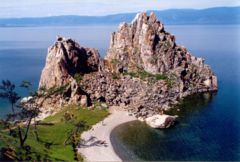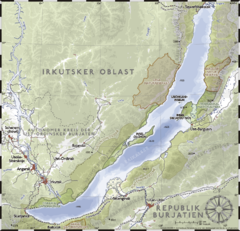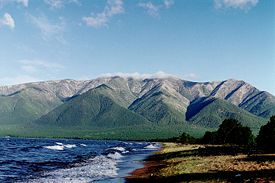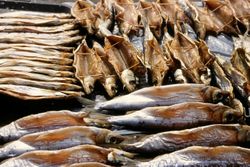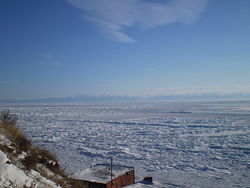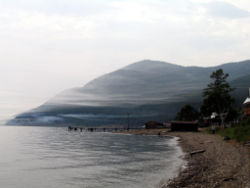Lake Baikal
2008/9 Schools Wikipedia Selection. Related subjects: Geography of Asia
| Lake Baikal | |
|---|---|
|
|
|
| Coordinates | |
| Lake type | Continental rift lake |
| Primary inflows | Selenga, Chikoy, Khilokh, Uda, Barguzin, Upper Angara |
| Primary outflows | Angara |
| Catchment area | 560,000 km² (216,000 sq mi) |
| Basin countries | Russia |
| Max. length | 636 km (395 mi) |
| Max. width | 79 km (49 mi) |
| Surface area | 31,494 km² (12,159.9 sq mi) |
| Average depth | 758 m (2,487 ft) |
| Max. depth | 1,637 m (5,371 ft) |
| Water volume | 23,600 km3 (5,700 cu mi) |
| Residence time (of lake water) | 350 years |
| Shore length1 | 2,100 km (1,300 mi) |
| Surface elevation | 456 m (1,496 ft) |
| Frozen | January-May |
| Islands | 22 ( Olkhon) |
| Settlements | Irkutsk |
| 1 Shore length is not a well-defined measure. | |
Lake Baikal (Russian: о́зеро Байка́л Ozero Baykal, pronounced [ˈozʲɪrə bʌjˈkɑl], Buryat: Байгал нуур Baygal nuur) is in Southern Siberia in Russia, located between Irkutsk Oblast to the northwest and the Buryat Republic to the southeast, near the city of Irkutsk. It is also known as the "Blue Eye of Siberia". It contains more water than all the North American Great Lakes combined.
At 1,637 meters (5,371 ft), Lake Baikal is the deepest lake in the world, and the largest freshwater lake in the world by volume, holding approximately twenty percent of the world's total surface fresh water. Like Lake Tanganyika, Lake Baikal was formed in an ancient rift valley and therefore is long and crescent-shaped with a surface area (31,500 km²) less than half that of Lake Superior or Lake Victoria. Baikal is home to more than 1,700 species of plants and animals, two thirds of which can be found nowhere else in the world and was declared a UNESCO World Heritage Site in 1996. At more than 25 million years old, it is the oldest lake in the world.
Geography and hydrography
Very little was known about Lake Baikal until the Trans-Siberian railway was built between 1896 and 1902. The scenic loop encircling Lake Baikal needed 200 bridges and 33 tunnels. As this railway was being built, a large hydrogeographical expedition headed by F.K. Drizhenko produced the first detailed atlas of the contours of Baikal's depths. The atlas demonstrated that Lake Baikal has more water than all of North America's Great Lakes combined — 23,600 cubic kilometers (5,662.4 cu mi), about one fifth of the total fresh water on the earth. However, in surface area, it is exceeded by the much shallower Great Lakes Superior, Huron and Michigan in North America, as well as by the relatively shallow Lake Victoria in East Africa. Known as the "Galápagos of Russia", its age and isolation have produced some of the world's richest and most unusual freshwater fauna, which is of exceptional value to evolutionary science.
Lake Baikal is in a rift valley created by the Baikal Rift Zone, where the crust of the earth is pulling apart. At 636 kilometers (395 mi) long and 79 kilometers (49 mi) wide, Lake Baikal has the largest surface area of any freshwater lake in Asia ( 31,494 km²) and is the deepest lake in the world (1,637 metres, previously measured at 1,620 metres). The bottom of the lake is 1,285 metres below sea level, but below this lies some 7 kilometers (4.3 mi) of sediment, placing the rift floor some 8–9 kilometers (more than 5 miles) below the surface: the deepest continental rift on Earth. In geological terms, the rift is young and active—it widens about two centimeters per year. The fault zone is also seismically active: there are hot springs in the area and notable earthquakes every few years. It drains into the Angara tributary of the Yenisei.

Its age is estimated at 25–30 million years, making it one of the most ancient lakes in geological history. It is unique among large, high-latitude lakes in that its sediments have not been scoured by overriding continental ice sheets. US and Russian studies of core sediment in the 1990s provide a detailed record of climatic variation over the past 250,000 years. Longer and deeper sediment cores are expected in the near future. Lake Baikal is furthermore the only confined fresh water lake in which direct and indirect evidence of gas hydrates exists.
The lake is completely surrounded by mountains. The Baikal Mountains on the north shore and the taiga are technically protected as a national park. It contains 22 islands; the largest, Olkhon, is 72 kilometers (45 mi) long. The lake is fed by as many as three hundred and thirty inflowing rivers. The main ones draining directly into Baikal are the Selenga River, the Barguzin River, the Upper Angara River, the Turka River, the Sarma River and the Snezhnaya River. It is drained through a single outlet, the Angara River.
Despite its great depth, the lake's waters are well-mixed and well-oxygenated throughout the water column compared to the stratification that occurs in such bodies of water as Lake Tanganyika and the Black Sea.
Olkhon, the largest island in Lake Baikal, is the fourth-largest lake-bound island in the world.
Wildlife
The extent of biodiversity present in Lake Baikal is equaled by few other lakes. Lake Baikal hosts 1,085 species of plants and 1,550 species and varieties of animals. Over 80% of animals are endemic. Epischura baikalensis is endemic to Lake Baikal and the dominating zooplankton species there: 80 to 90 percent of total biomass. The Baikal Seal or nerpa (Phoca sibirica), is found throughout Lake Baikal. It is one of only 3 entirely freshwater seal species in the world, the other being the two subspecies of freshwater Ringed Seal. Perhaps the most important local species is the omul (Coregonus autumnalis migratorius), a smallish endemic salmonid. It is caught, smoked, and sold widely in markets around the lake.
Of particular note are the two species of golomyanka or Baikal oil fish (Comephorus baicalensis and C. dybowskii). These long-finned, translucent fish live in depths of 700 to 1600 feet and are the primary prey objects of the Baikal seal, representing the largest fish biomass in the lake. They are famous for disintegrating into a pool of oil and bones when withdrawn rapidly from the high pressures of the deep water. The Baikal grayling (Thymallus arcticus baicalensis), a fast swimming salmonid popular among anglers, and the Baikal sturgeon (Asipenser baerri baicalensis) are both important endemic species with commercial value.
Bear and deer are common and hunted along Baikal shores.
Research
Several organizations are carrying out natural research projects on Lake Baikal. Most of them are governmental or associated with governmental organizations. The Baikalian Research Centre is an independent research organization carrying out environmental educational and research project at Lake Baikal.
Tourism
The lake called "the Pearl of Siberia" drew investors from the tourist industry since energy revenues sparked an economic boom. Viktor Grigorov's Grand Baikal in Irkutsk is one of the investors who planned to build three hotels creating 570 jobs. In 2007, the Russian government declared the Baikal region a special economic zone. The popular resort of Listvyanka has a seven-story Hotel Mayak. Baikal is a UNESCO World Heritage site. Rosatom plans to build a laboratory in Baikal, in conjunction with an international uranium plant and to invest $2.5bn in the region and create 2,000 jobs in the city of Angarsk.
Environmental concerns
Baykalsk pulp and paper mill
Baykalsk Pulp and Paper Mill (BPPM) was constructed in 1966 directly on the shore line. The BPPM bleaches its paper with chlorine and discharges the waste into Baikal. Despite numerous protests, the BPPM is still in production. Environmental activists are now struggling to make the pollution less harmful rather than end BPPM's production since a plant shutdown would destroy valuable jobs.
Planned East Siberia-Pacific Ocean oil pipeline
Russian oil pipelines state company Transneft was planning to build a trunk pipeline that would have come within 800 meters (2,620 ft) of the lake shore in a zone of substantial seismic activity. Environmental activists in Russia, Greenpeace, Baikal pipeline opposition and local citizens were strongly opposed to these plans due to the possibility of an accidental oil spill that might cause significant damage to the environment. According to the Transneft's president, numerous meetings with ordinary citizens were held in towns along the route, especially in Irkutsk. However, it was not until Russian president Vladimir Putin ordered the company to consider an alternative route 40 kilometers (25 mi) to the north to avoid such ecological risks that Transneft agreed to alter its plans. Transneft has since decided to move the pipeline away from Lake Baikal so that it will not pass through any federal or republic natural reserves.
Work began on the pipeline two days after President Putin agreed to changing the route away from Lake Baikal.
Proposed nuclear plant
In 2006, the Russian Government announced plans to build the world's first International Uranium Enrichment Centre at an existing nuclear facility in Angarsk, 95 kilometres from the lake's shores. But critics argue it would be a disaster for the region and are urging the Government to reconsider.
After the uranium is enriched, only 10 per cent of the radioactive material would be returned to customers abroad, leaving 90 per cent in the Lake Baikal region for storage. Uranium tails, the leftover waste after the enrichment process, contain radioactive and toxic materials, which are very dangerous to humans and can contaminate rivers and lakes.
